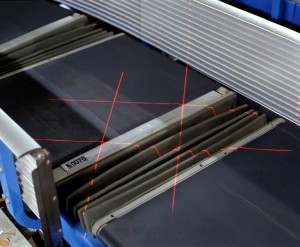Flexible automation for demanding mail

The British Forces Post Office (BFPO) sorting centre at RAF Northolt in West London is like no other. Part of the Defence Equipment and Support (DE&S), it is run on tight commercial principles to achieve the best value for public money. But it also has a vital service role to play in boosting the morale of service men and women.
Its duty of care is definitely in the ‘above and beyond’ category, ensuring all members of the UK’s armed forces – around 150,000 in total – receive their mail with the utmost efficiency, wherever they are in the world. BFPO production volumes are in the order of 24 million per annum.
Delivering mail to individuals in theatre or serving away from home is just one of its functions however. BFPO is also responsible for small volumes of official mail for the Foreign and Commonwealth Office and non-classified Ministry of Defence mail, all within the UK. Added to that it acts as the dispatch centre for ancillary items such as postage stamps, savings bonds and Government stationery for UK bases abroad.
Exceptional variety of mail
This multiplicity of tasks makes effective automation a tall order especially as many parcels, packages and flats have to be sorted by hand; their shape or the nature of their packaging dictates it. However, in 2007 the decision was taken to automate as much of the sorting process as possible and the search began for a system that could provide the flexibility required.
Crisplant was chosen as the principal supplier and integrator for the sorting system, under whose command Prime Vision provided its ParcelMatch platform, Read-IT automated address reading, Key-IT video coding and Archive-IT image archiving. The resultant system is based on a Crisplant S3000CB cross belt sorter, selected for its ability to sort fragile and high-friction items. It is equipped with AccuSort cameras to take images of the front and back of parcels; weighing, dimensioning and bar code reading are also integrated.
The project specification required 40% of the non-letter stream to be automatically read on first scan. Due to the sensitive nature of the operation, guarantees also had to be given that downtime in excess of 12 hours would be met by on-site response by Crisplant and Prime Vision. Indeed, Crisplant now has a full time engineer working on site to ensure smooth operation and Prime Vision provide (24/7) on-line support.

High first time read rate
In reality the Prime Vision OCR/ICR software is maintaining a first time read rate of 46%. This high achievement is thanks to the company’s particular prowess in reading handwritten text and region of interest finding techniques.
“BFPO customers are largely wives, husbands and partners communicating to and from the front line,” confirms Automation Manager, Staff Sergeant Ty Wales. “So a lot of what we handle is addressed by hand and we also have to compensate for quite a lot of addressing mistakes. Missing or incorrect BFPO numbers are common.”
Whilst most OCR products are primarily designed for reading machine printed text, Prime Vision’s ParcelMatch system is based on algorithms for handwritten characters and script. As a result it has become the OCR of choice for applications where the automatic capture of handwritten information is a pre-requisite. It is also competent at reading machine printed text so this was clearly the ideal combination for the BFPO application.
A number of other ParcelMatch features contribute to the high first time read rate at BFPO. Region of interest techniques, for example, provide the sign posts that tell the OCR where to decode. Various helper tools assist this process including an offline Label Identification Tool that uses barcodes and other symbols on the label as a guide. With Prime Vision’s new Smart Label Identification algorithms, up to 50 different label formats can be identified, providing a stable reference point to boost recognition.

85% automatically read
The remainder of BFPO Post – around 54% – remains on the sorter for 90 seconds for another scan to be performed before further action is taken. This can range from Prime Vision Key-IT video coding in the dedicated coding room through to full manual handling of items such as footballs that would otherwise roll off the conveyor!
Ty Wales continues: “Video coding boosts our automatic read rate to around 85% and typical candidates include cellophane wrapped items such as Soldier Magazine that the camera struggles to read due to reflection from the packaging. The remaining 15% has to be manually handled and sorted into bins for low and high BFPO numbers, Defence and Military UK mail, Foreign and Commonwealth Office UK mail and ships. Each bin is then taken to its respective department for dispatch.”
He adds: “Our automation processes are very good and we receive excellent support from both Crisplant and Prime Vision.”
Detective work
Each BFPO base, on land or on board ship, has its own unique four digit numerical code and mistakes are often made by the sender in this regard. A parcel may carry the wrong code or simply the name of the base, for example, The Princess Royal Barracks in Germany. This will then require some cross checking as there are in fact four barracks in Germany by that name. So there is a high degree of investigative work involved too, undertaken by BFPO’s experienced and dedicated staff.
The Prime Vision ParcelMatch software is designed to read the address detail from the bottom upwards. The first alpha-numeric code it is likely to encounter will be the HA4 post code of the BFPO office at Northolt confirming that the mail item is indeed in the right place! The second is the BFPO number that identifies the base or ship.
Having captured this number, the system then automatically routes the parcel or packet to a sack chute if it is under 2kg, or the waterfall chute if it is above that weight. Understandably currently Afghanistan receives a considerable volume of mail but German bases are also subject to a daily delivery service.
Parcel volumes on the increase
In common with all posts, the growth in e-commerce has seen a steady increase in parcel handling at BFPO. Historically the cost involved in sending parcels over 2kg to the front line was jointly met by Royal Mail and the UK Government. This still applies to mailed items under this weight but with greater parcel volume, revenue recovery for goods above 2kg could not be ignored.
In accordance with the service agreement BFPO has with the UK forces it dispatches a mail item to its destination within 24 hours of receipt at the cost of a UK inland delivery.
To recover the on-cost from the UK, a bar code is now affixed to the parcel when it arrives at the Commercial Receipts department at the sorting office. This gives the parcel a unique ID that also identifies its supplier. In this way the weight and dimension of the parcel, that are automatically captured on the sorter, can be electronically tagged to its image by the Prime Vision system so that the BFPO accounts department in Liverpool can invoice the goods supplier accordingly. This could be any commercial company but typical suppliers are Next and Amazon.
Ty Wales confirms: “Internet shopping is massive now and the cost to BFPO and the Government was rising rapidly. The revenue recovery system we now have in place allows us to reclaim up to £1m per annum from suppliers.” It has allowed BFPO to add value to the service it provides to its customers, without dipping too far into the public purse.”
The Prime Vision Archive-IT image archiving ability of the system is also proving valuable with the rise in parcel volumes, both from a customer care standpoint and also in support of BFPO’s dealings with commercial suppliers. It provides proof of handling, condition and confirmation of weight and dimensions.
Upgrade path
Such has been the success of the initial Crisplant automation system and Prime Vision software that BFPO has now sanctioned an upgrade. The proven Crisplant sorter has been equipped with a SICK 6-sided camera tunnel with a separate camera on each feeding station to read the bottom surface of the parcel; Siemens voice recognition will also be installed on the induction lines.
The new camera tunnel is now in situ and with new fibre optic cabling installed to enhance communication speed, switch over to the new system is in sight. From a software standpoint, this has involved Prime Vision working closely with SICK to develop the necessary interfaces for the new multi-sided data capture.
Early trials confirm a read rate improvement of up to 8% and this is largely thanks to the better image performance provided by the new camera technology.
The latest generation ParcelMatch system that has been incorporated into the upgrade is designed to allow automated mixed media handling to be scaled up without incurring expansion costs. It will enable BFPO to grow in a steady, structured way by maximising resources.
Quelle: www.primevision.com
Schlagwörter: PrimeVision








